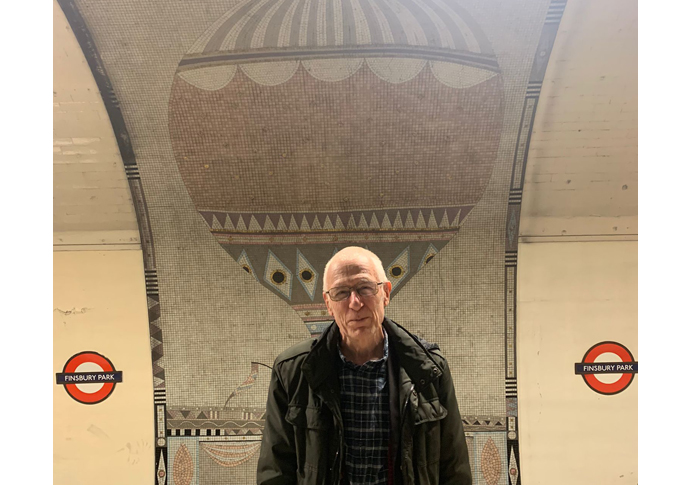Happy birthday to tube balloonomania!
Four decades of platform mosaics at Finsbury Park station
Thursday, 6th April 2023 — By Izzy Rowley and Anna Lamche

Tube enthusiast Ian MacDonald at the station
FOR four decades, hot air balloons have floated six metres below ground in one of the borough’s busiest stations.
Designed by artist Annabel Grey, this year marks the fortieth anniversary of the unveiling of Finsbury Park’s platform mosaics.
Commissioned by London Transport – the precursor to Transport for London – in 1983, the artist said she chose the balloon designs to bring levity to the depths of the station. She also designed two sets of pillars and two “headwalls” for each platform.
“I came up with various designs based on the park and ponds, ducks and trees, and I’d put a small balloon in the sky,” the artist said in an interview with Creative Review in 2013.
“Then I came up with just the hot air balloons. I thought it was elevating, as Finsbury Park is a very deep tunnel and the balloons are a simple shape. They started off low, they rise up and then come down over the six panels.”
Adorning the walls of the southbound Piccadilly line platform, the artworks were made with 52 differently-coloured tiles, sourced by the artist after a trip to the Italian city of Vicenza. The mosaics are still well-loved today, and admired by commuters and passers-by alike.
Ian MacDonald, a tube-enthusiast who often comes through Finsbury Park station was among the passengers the Tribune spoke to yesterday (Thursday).
“I really like the mosaics. There’s a different one at every station along the Victoria line.I remember the mosaics from when the Victoria line first opened,” he said.
“I went on it the first day it opened, just a few hours after the Queen travelled on it. I didn’t get out here though, because I went all the way to Walthamstow.”
It is widely believed the balloons are a mistaken reference to the world’s first hot air balloon ride, which was launched from Finsbury Fields, roughly 3.5 miles to the south, near Moorgate.
The Fields, once a run of open farmland, have long since been built over.
But in 1784, 200,000 people gathered there to watch the Italian aviator Vincenzo Lunardi launch a hydrogen balloon, accompanied by a dog, a cat and a pigeon, launching a wave of “Balloonomania” that swept across the country.
Micheal Ryan, who comes through Finsbury Park station twice a day on his commute, said he appreciates the oddity of the mosaic’s figures.
“I think the more different it is the better. If it’s a hot air balloon, then brilliant,” he said.
“It gives the place a boost and the colouring on them is lovely.”
Another woman said: “I think it’s a shame that some of the advertising around them detracts from it. I’m really into art, I love graffiti, it really livens the place up.”
Ms Grey had said her team was given a budget of £15,000 to buy gold mosaic tiles – despite the “bitter pill” of austerity budgets imposed on the wider country by Margaret Thatcher through the 1980s.
London Transport was overseen by the Labour-controlled Greater London Council at the time Ms Grey was commissioned.
Ms Grey’s work was the continuation of a long London Transport tradition of “station-specific” public art, launched by publicist (and later London Transport chief executive) Frank Pick in the early 1900s. This is a tradition that continues to this day, under the stewardship of TfL’s Art on the Underground programme.